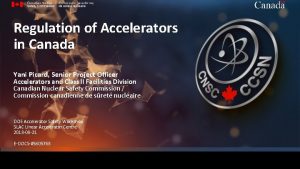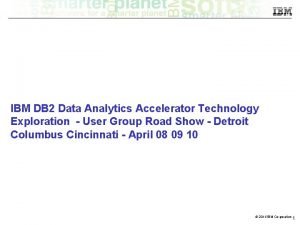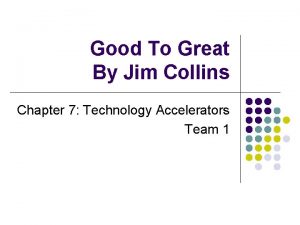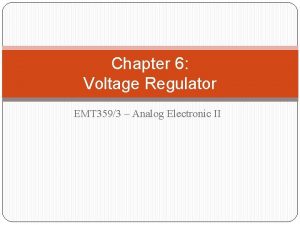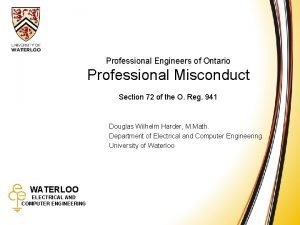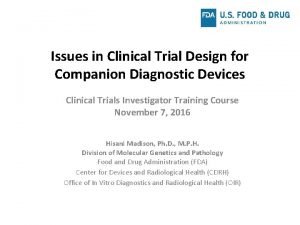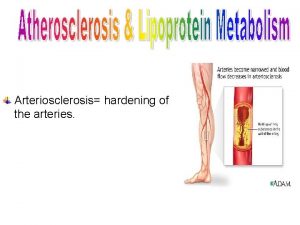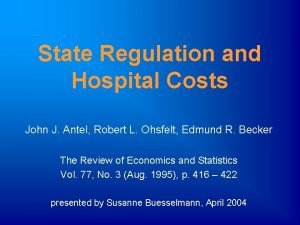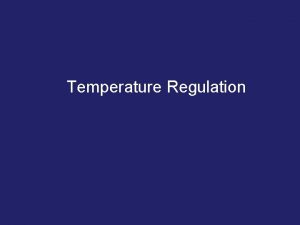Regulation of Accelerators in Canada Yani Picard Senior






































- Slides: 38

Regulation of Accelerators in Canada Yani Picard, Senior Project Officer Accelerators and Class II Facilities Division Canadian Nuclear Safety Commission / Commission canadienne de sûreté nucléaire DOE Accelerator Safety Workshop SLAC Linear Accelerator Centre 2018 -08 -21 E-DOCS-#5605768

Presentation outline The Canadian Nuclear Safety Commission (CNSC) and its Regulatory Approach CNSC oversight of accelerators Class IB accelerators in Canada Licensing of Class IB accelerators Regulatory compliance of Class IB accelerators Responsive regulator 2

The Canadian Nuclear Safety Commission (CNSC) and its regulatory approach 2018 -08 -21 DOE Accelerator Safety Workshop 3

Canadian Nuclear Safety Commission Regulates the use of nuclear energy and materials to protect health, safety, security and the environment Implements Canada's international commitments on the peaceful use of nuclear energy Disseminates objective scientific, technical and regulatory information to the public We will never compromise safety 4

The CNSC regulates all nuclear facilities and activities in Canada Uranium mines and mills Uranium fuel fabrication and processing Nuclear power plants Nuclear substance processing Industrial and medical applications Nuclear research and educational activities Transportation of nuclear substances Nuclear security and safeguards Import and export controls Waste management facilities …from cradle to grave 5

CNSC staff located across Canada Fiscal year 2016– 17 Human resources: 850 full-time employees Financial resources: $148 million (~ 70% cost recovery; ~ 30% appropriation) Licensees: ~ 1, 700 Licences: ~ 2, 500 HQ in Ottawa 4 site offices at power plants 1 site office at Chalk River 4 regional offices 6

Independent Commission Quasi-judicial administrative tribunal Agent of the Government of Canada (the Crown) Reports to Parliament through Minister of Natural Resources Commission members are independent and part-time Commission hearings are public and webcast Staff presentations in public Decisions are reviewable only by Federal Court Transparent, science-based decision making 7

Safety – the cornerstone of the CNSC mandate Section 24(4) of the Nuclear Safety and Control Act (NSCA) No licence shall be issued, renewed, amended or replaced… unless, in the opinion of the Commission, the applicant… (a) is qualified to carry on the activity that the licence will authorize the licensee to carry on; and (b) will, in carrying on that activity, make adequate provision for the protection of the environment, the health and safety of persons and the maintenance of national security and measures required to implement international obligations to which Canada has agreed Regulatory philosophy Licensees responsible for the protection of health, safety, security and the environment, and respecting Canada’s international commitments CNSC responsible for regulating licensees, and assessing whether licensees are compliant with the NSCA, regulations, and international obligations The Licensees are held accountable by their licence 8

Regulatory framework Adaptable to an evolving industry and advancements in policy, science and engineering Risk-informed and independent of technology 9

Regulatory approach The CNSC establishes safety requirements − − Graded approach − applicant proposes how to meet the requirements CNSC regulations were designed to allow for flexibility safety commensurate with risk Uses a mix of management, performance-based and prescriptive approaches used − − a largely performance-based approach is used for accelerators a more prescriptive approach is used for nuclear substances and radiation devices Many requirements allow for alternative approaches to meet their safety objectives 10

CNSC oversight of accelerators 11

Medical applications (Class II) Source: CNSC 225 accelerators used primarily for cancer treatment 12

Industrial applications (Class II) Source: CNSC 9 accelerators used for cargo screening, sterilization, radiography 13

Commercial applications (Class II) Source: CNSC Source: advancedcyclotron. com 24 accelerators including isotope producers and third-party servicing companies 14

Research applications (Class IB and Class II) Source: triumf. ca Prototype MR-Linac (source: mp. med. ualberta. ca) 10 accelerators used for physics research, imaging, prototype development 15

Class IB accelerators in Canada 16

Class IB accelerators Particle accelerators capable of producing nuclear energy and has a beam energy of more than 50 Me. V for particles with a mass ≤ 4 amu* 15 Me. V/amu for particles with a mass > 4 amu *amu: atomic mass unit 17

Class IB accelerator facilities Only 2 Class IB accelerators in Canada: Tri-University Meson Facility (TRIUMF) – Cyclotron: 520 Me. V proton accelerator – Vancouver, British Columbia Canadian Light Source (CLS) – Synchrotron: 2. 9 Ge. V electron accelerator – Saskatoon, Saskatchewan Research accelerator facilities 18

Class IB accelerator facilities 19

Communications facility-CNSC Single point of contact – Facility: Radiation Safety Officer (RSO) – CNSC: Project Officer (PO) Communication on average 2 -3 times a week – Corrective action updates – New projects (safety analysis, licensing, etc. ) – Reportable events 20

Licensing of Class IB accelerators 21

Licensing process, new application Class IB nuclear facilities 22

New licence application timeframe Class IB nuclear facilities Class II nuclear facilities LTC 8 wks LTOC 6 wks LTO 2 wks LTOC: Licence to Operate for Commissioning 23

Safety and Control Areas (SCA) Management system Human performance management Other matters of interest Operating performance Aboriginal Consultations Safety analysis Public Information and Disclosure Program Physical design Financial Guarantees Fitness for service Radiation protection Conventional health and safety Environmental protection Emergency management and fire protection Waste management Security Safeguards and non-proliferation Packaging and transport 24

Licence to operate Usually valid for 10 years Includes a Licence Conditions Handbook LCH updates may be approved by management 25

Licence Conditions Handbook (LCH) 26

Regulatory compliance of Class IB accelerators 27

Risk-informed approach Risk of the facility Operational performance Compliance history Changes in operations Changes in regulatory framework 28

CNSC internal resources Safety and Control Areas Specialists Project Officer Management system √ √ Human performance management √ √ Operating performance √ Safety analysis √ Physical design √ Fitness for service √ Radiation protection √ Conventional health and safety √ √ Environmental protection √ √ Emergency management and fire protection √ √ Waste management √ √ Security √ √ Safeguards and non-proliferation √ √ Packaging and transport √ √ 29

Compliance tools Annual Compliance Reports – Due on March 31 of the following year Inspections – Type I: Audit of the whole facility – Type II: Specific to one or a few safety and control areas – 2 -3 times/year – PO (lead) with a team of specialists 30

Risk-informed inspection frequency (from risk index) Safety and Control Areas TRIUMF CLS Management system Every 2 -3 years Human performance management Every 2 -3 years Operating performance Every 2 -3 years Safety analysis Every 4 -5 years Physical design Every 4 -5 years Fitness for service Every 2 -3 years Radiation protection Every 2 -3 years Conventional health and safety Every 1 -2 years Every 2 -3 years Environmental protection Every 4 -5 years Emergency management and fire protection Every 2 -3 years Every 4 -5 years Waste management Every 2 -3 years Not applicable Security Every 4 -5 years Safeguards and non-proliferation Every 4 -5 years Not applicable Packaging and transport Every 2 -3 years Not applicable 31

No surprise approach Project officer provides expectations about one month prior to the inspection Expectations based on the Act, regulations, LCH, and regulatory documents, standards and licensee’s procedures referenced in LCH Opportunity to perform correct non-compliances 32

Typical inspection of Class IB accelerator facilities Activities: – Opening meeting – Walkthrough/observations – Interviews/Verification of records – Daily RSO briefings – Closing meeting/preliminary report Duration: – 3 days of inspection (Tuesday to Thursday) – Many more hours of preparation and report writing 33

Final inspection report Prepared by PO with collaboration of specialists Sent to licensee within 8 weeks of the inspection Contains non-compliances and recommendations Licensee must provide a corrective action plan for each non-compliance within 6 weeks of receiving the report PO oversees the corrective actions 34

Responsive regulator 35

Considerations for Regulators Make regulated parties responsible Review processes and hold licensees accountable Stay flexible to technological developments Allow testing and development with appropriate safety margins Leverage industry best practices and consensus standards Make appropriate use of prescriptive requirements Be responsive to evolving expectations and trends Continuous effort to maintain and modernize regulatory framework 36

The CNSC will never compromise safety… …it’s in our DNA! nuclearsafety. gc. ca 37

Find Out More About Us Visit us online Participate and contribute Like us on Facebook Follow us on Twitter View us on You. Tube Subscribe to updates nuclearsafety. gc. ca Contact us 38
 Yani picard
Yani picard Amanda picard
Amanda picard Yani picard
Yani picard Cosmic super accelerators
Cosmic super accelerators Slidetodoc
Slidetodoc Analytics query accelerators
Analytics query accelerators Good to great technology accelerators
Good to great technology accelerators The long-term future of particle accelerators
The long-term future of particle accelerators Good to great technology accelerators
Good to great technology accelerators Accelerators computer architecture
Accelerators computer architecture Yani kusmarni
Yani kusmarni Kaliopenie
Kaliopenie Maurice picard
Maurice picard Liza picard
Liza picard Lbo principe
Lbo principe Fontaine et picard
Fontaine et picard Sojourner truth
Sojourner truth Foldback current limiter
Foldback current limiter Outcomes focused regulation
Outcomes focused regulation Ohs risk assessment tool
Ohs risk assessment tool Ch 18+
Ch 18+ Blood glucose level regulation
Blood glucose level regulation Line regulation formula
Line regulation formula Regulation asservissement
Regulation asservissement Types of regulation of enzyme activity
Types of regulation of enzyme activity Vacuole transport
Vacuole transport Regulation of gene expression in bacteria
Regulation of gene expression in bacteria Guided self regulation
Guided self regulation Differential gene regulation
Differential gene regulation Section 12-1 dna answers
Section 12-1 dna answers Attendance regulation
Attendance regulation Prokaryotes vs eukaryotes gene regulation
Prokaryotes vs eukaryotes gene regulation Regulation and inspection of social care wales
Regulation and inspection of social care wales Professional engineers act section 72
Professional engineers act section 72 Companion diagnostic regulation
Companion diagnostic regulation A psu converts alternating current to what
A psu converts alternating current to what Atorvastatin lactone
Atorvastatin lactone What animals are cold blooded
What animals are cold blooded Prating regulation
Prating regulation


